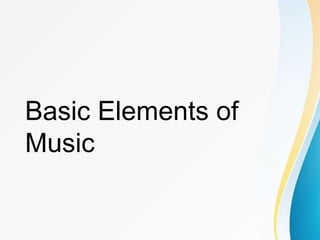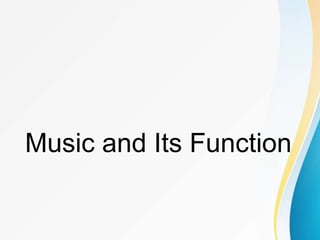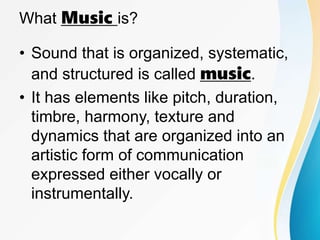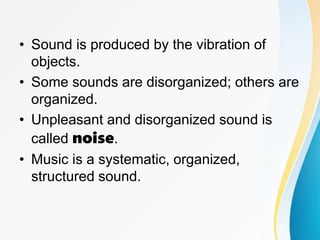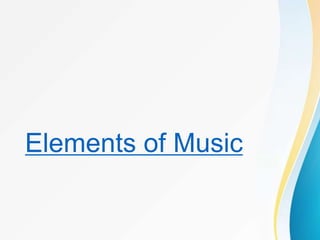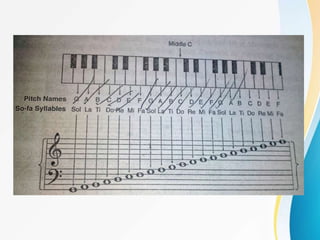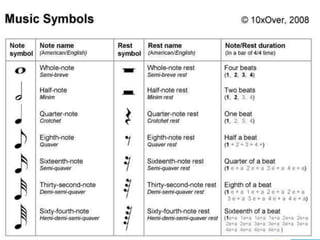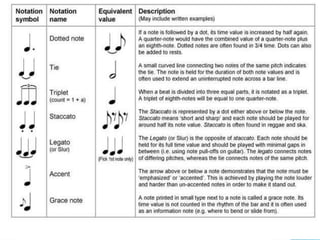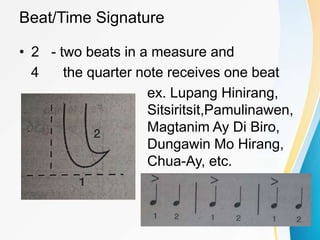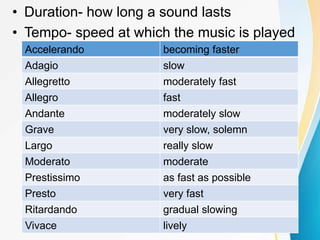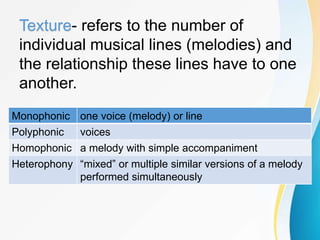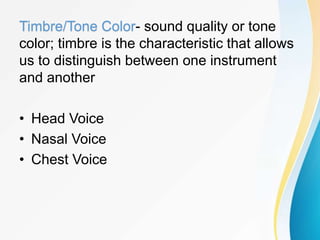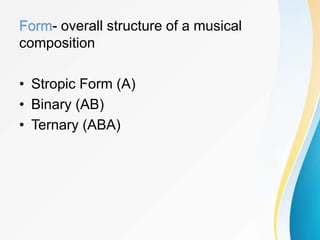Basic Elements of Music
- 2. Music and Its Function
- 3. What Music is? • Sound that is organized, systematic, and structured is called music. • It has elements like pitch, duration, timbre, harmony, texture and dynamics that are organized into an artistic form of communication expressed either vocally or instrumentally.
- 4. Functions of Music • Music is an important ingredient in our daily lives. Its value depends on our purposes, whether for celebrations, rites, rituals, and/or special occasions.
- 5. Function Specifications Examples 1. Aesthetics • It provides a sense of achievement, happiness, and satisfaction. • It is very personal and intimate. No two listeners have equally the same emotional response. “Jesu Joy of Man's Desiring” by Johann Sebastian Bach 2. Emotional Appeal • It helps in the release of emotions and in the expression of one's feelings in the lines of a song or the melodic movemen of the instrumental piece. “Anak” by Freddie Aguilar
- 6. Function Specifications Examples 3. Nationalistic Fervor • It is an effective means to develop nationalism, strengthen national discipline, and transmitting cultural values, history, and oral traditions. “Bayan Ko” by Constancio de Guzman “Mutya ng Pasig” by Nicanor Abelardo 4. Artistic Forms and Academic Disciplines • It is used to convey ideas. “Magkaugnay” by Joey Ayala 5. Medium between God and people • It is used to communicate with God. “Dona Nobis Pacem” by Kerenyi Gyorgy 6.Comparison in Work • It keeps workers inspired to do their best in their tasks. “Magtanim ay Di Biro” Phil. folk song
- 7. Function Specifications Examples 7. A Form of Entertainment • It provides entertainment for different occasions, celebrations, and programs. • It allows appreciation of musical skills. “Ikaw” by Yeng Constantino 8. Tool of Marketing • It promotes products new in the market. “Beat Energy Gap” by James Reid
- 8. • Sound is produced by the vibration of objects. • Some sounds are disorganized; others are organized. • Unpleasant and disorganized sound is called noise. • Music is a systematic, organized, structured sound.
- 9. ACTIVITY • SING A FEW LINES OF YOUR FAVORITE SONG IN CLASS AND TELL ITS IMPORTANCE IN YOUR LIFE.
- 11. Rhythm • the time element of music. • A specific rhythm is a specific pattern in time; we usually hear these in relation to a steady pulse, and mentally organize this pulse or tempo into meter (sometimes called a "time signature"). • Meter organizes beats into groups, usually of two or three; beats can be divided into small units usually 2, 3 or 4 subdivisions
- 16. Beat/Time Signature • 2 - two beats in a measure and 4 the quarter note receives one beat ex. Lupang Hinirang, Sitsiritsit,Pamulinawen, Magtanim Ay Di Biro, Dungawin Mo Hirang, Chua-Ay, etc.
- 17. • 3 - three beats in a measure and 4 the quarter note receives one beat ex. Atin Cu Pung Singsing, Santa Clara, Sarung Banggi, Pasyon, Bahay Kubo, Mutya Ng Pasig, Nasaan Ka Irog
- 18. • 4 - four beats in a measure and 4 the quarter note receives one beat ex. Leron Leron Sinta, Dios Te Salve, Ode to Joy, If You're Happy and You Know It, London Bridge, etc.
- 19. • Duration- how long a sound lasts • Tempo- speed at which the music is played Accelerando becoming faster Adagio slow Allegretto moderately fast Allegro fast Andante moderately slow Grave very slow, solemn Largo really slow Moderato moderate Prestissimo as fast as possible Presto very fast Ritardando gradual slowing Vivace lively
- 20. Dynamics • refers to the loudness and softness of sound. Crescendo Decresendo Forte loud Piano soft Mezzo forte medium loud Mezzo piano medium soft Crescendo getting louder Decresendo getting softer
- 21. • A composition that has extremely soft passages as well as extremely loud passages is said to have a large or wide dynamic range. • Dynamics can change suddenly or gradually (crescendo, getting louder, or decrescendo, getting softer.)
- 22. Melody • It is the horizontal succession of notes written or performed in a recognizable shape. Wide Range 8 tones & above Moderate Range 5 tones Narrow Range 1-3 tones
- 25. Melodic Direction Step- line to space Skip- line to line, space to space Leap- more than a step
- 26. Texture- refers to the number of individual musical lines (melodies) and the relationship these lines have to one another. Monophonic one voice (melody) or line Polyphonic voices Homophonic a melody with simple accompaniment Heterophony “mixed” or multiple similar versions of a melody performed simultaneously
- 27. Harmony- vertical arrangement and simultaneous sound production of notes that blend into a chord is • Dissonance- a harsh-sounding harmonic combination • Consonance- a smooth-sounding harmonic combination
- 28. Timbre/Tone Color- sound quality or tone color; timbre is the characteristic that allows us to distinguish between one instrument and another • Head Voice • Nasal Voice • Chest Voice
- 29. • Idiophone (gong, cymbals, xylophone) • Membranophone (drum) • Chordophone (guitar, violin) • Aerophone (flute) • Electrophone (piano, electric guitar)
- 30. Form- overall structure of a musical composition • Stropic Form (A) • Binary (AB) • Ternary (ABA)

